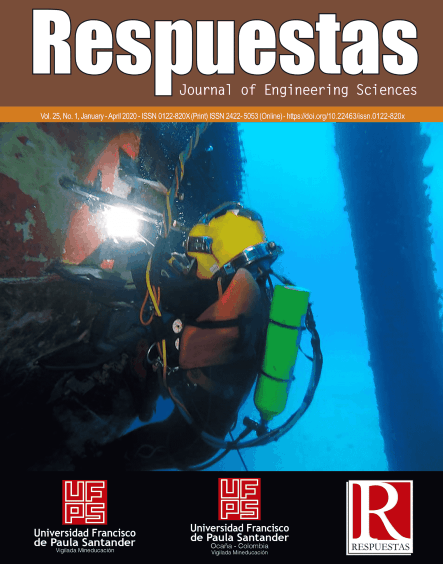Corrosion resistance of bainitic steels alloyed with boron
Resistencia a la corrosión de los aceros bainíticos aleados con boro
Main Article Content
Due to its good combination of properties and its wide range of application in the automotive and rail sector, among others, banitic steels have been studied by modifying their chemical composition using different alloys in order to improve their resistance, as is the case of boron, which is an element that allows to increase the mechanical properties of steel and its behavior against phenomena such as wear when is used in small quantities. In the present investigation, through of saline chamber and potentiodynamic polarization tests, the influence of boron was studied in steels with bainitic microstructure against phenomena as corrosion by varying its percentage in each sample analyzed, which was developed from the measurement of parameters such as the percentage of corroded area and the current density. Although no significant influence of boron was observed in the saline chamber results, in potentiodynamic polarization, a greater reduction in current density was observed for steel with a higher boron content, which results in a better resistance to corrosion compared to other steels that had a lower percentage of this element.
Downloads
Article Details
M. C. García, F. G. Caballero, T. Sourmail, M. Kuntz, J. Cornidea, V. Smanio and R. Elvira, “Tensile behaviour of a nanocrystalline bainitic steel containing 3 wt% silicon”, Materials Science and Engineering, vol. 549, pp. 185–192, 2012.
D. P. Cheprasov, “Constitution and conditions of formation of intermediate structures with granular morphology in low-carbon low-alloy steels of bainitic class”, Metal Science and Heat Treatment, vol. 52, pp. 7–12, 2010.
R. Mahnken, A. Schneidt, S. Tschumak and H.J. Maier, “On the simulation of austenite to bainite phase transformation”, Computational Materials Science, vol. 50, pp. 1823–1829, 2011.
A. Bardelcik, C. P. Salisbury, W. Sooky, M. A. Wells and M. J. Worswick, “Effect of cooling rate on the high strain rate properties of boron steel”, International Journal of Impact Engineering, vol. 37, pp. 694–702, 2010.
F. G. Caballero, M. K. Miller, S. S. Babu and M. Garcia, “Atomic scale observations of bainite transformation in a high carbon high silicon steel”, Acta Materialia, vol. 55, pp. 381–390, 2007.
X. M. Wang and X. L. He, “Effect of boron and addition on structure and properties of low carbon bainitic steels”, ISIJ International, vol. 42, pp. S38-S47, 2002.
O. Kazum, M. Kannan, H. Beladi, B. Timokhina, P. Hodgson and S. Khoddam, “Aqueous corrosion performance of nanostructured bainitic steel”, Materials and Design, vol. 54, pp. 67–71, 2014.
S. Qu, X. Pang, Y. Wang and K. Gao, “Corrosion behavior of each phase in low carbon microalloyed ferrite–bainite dual-phase steel: Experiments and modeling”, Corrosion Science, vol. 75, pp. 67–77, 2013.
F. Rosalbino, G. Sabino and G. Mortarino, “Electrochemical corrosion behaviour of innovative mould steels in a chloride-containing environment”, Materials and Corrosion, vol. 63, pp. 105–110, 2012.
Z. F. Wang, P. H. Li, Y. Guan, Q. F. Chen, S. K. Pu, “The corrosion resistance of ultra-low carbon bainitic steel”, Corrosion Science, vol. 51, pp. 954–961, 2009.
ASTM International, “Standard practice for conventions applicable to electrochemical and measurements in corrosion testing”, ASTM International Designation: G3-89, pp. 1–9, 2010.
ASTM International, “Standard reference test method for making potentiostatic and potentiodynamic anodic polarization measurements”, ASTM International Designation: G5-94, pp. 1–13, 2011.
ASTM International, “Standard practice for operating salt spray (Fog) apparatus”, ASTM International Designation: B117-11. pp. 1–12, 2011.
S. D. Bakshi, A. Leiro, B. Prakash and H. Bhadeshia, “Dry rolling/sliding wear of nanostructured bainita”, Wear, vol. 316, pp. 70-78, 2014.
N. M. Santofimia, “La transformación bainítica sin formación de carburos en aceros”, Madrid: Facultad de Ciencias Físicas, Departamento de Derecho de Física de Materiales, Universidad Complutense de Madrid, 2006.
S. Rojas, “Procesamiento y fabricación de aceros bainíticos con alta resistencia”, Morelia: Instituto de Investigaciones Metalúrgicas, Universidad Michoacana de San Nicolás de Hidalgo, 2009.
G. F. Melloy, P. R. Slimmon and P. Podgursky, “Optimazing the boron effect. Metallurgical Transactions”, vol. 4, pp. 2279–2289, 1973.
F. Guerra, J. A. Bedolla, I. Mejía, J. Zuno and C. Maldonado, “Effects of boron addition and austempering time on microstructure, hardness and tensile properties of ductile irons”, Materials Science & Engineering. vol. A 648, pp. 193–201, 2015.
A. Bedolla, F. Guerra, M. Rainforth, I. Mejía and C. Maldonado, “Sliding wear behavior of austempered ductile iron microalloyed with boron”, Wear, vol. 330–331, pp. 23–31, 2015.
S. Hakan, S. Polat and S. Zor, “Effect of Tempering Temperature and Microstructure on the Corrosion Behavior of a Tempered Steel”, Protection of Metals and Physical Chemistry of Surfaces, vol. 49, pp. 240–246, 2013.
A. Moon, S. Sangal, S. Layek, S. Giribaskar and K. Mondale, “Corrosion behavior of high-strength bainitic rail steels”, Metallurgical and Materials Transactions, vol. 46, pp. 1500–1518, 2015.
C. Xu, K. Shi, Y. Zhou, X. Li, Y. Liu and H. Wang, “Microstructures and corrosion properties of X80 pipeline steel in alkaline sand soil”, Transactions of JWRI, pp. 51–54, 2011.
C. W. Du, X. G. Li, P. Liang, Z. Y. Liu, G. F. Jia and Y. F. Cheng, “Effects of microstructure on corrosion of X70 pipe steel in an alkaline soil”, Journal of Materials Engineering and Performance, vol. 18, pp. 216–220, 2009.
M. P. Papadopoulos, C. A. Apostolopoulos, N. D. Alexopoulos and S. G. Pantelakis, “Effect of salt spray corrosion exposure on the mechanical performance of different technical class reinforcing steel bars”, Materials and Design, vol. 28, pp. 2318–2328, 2007.







